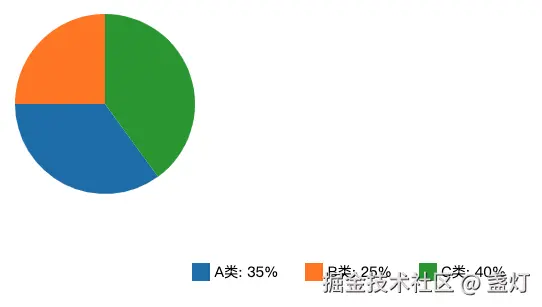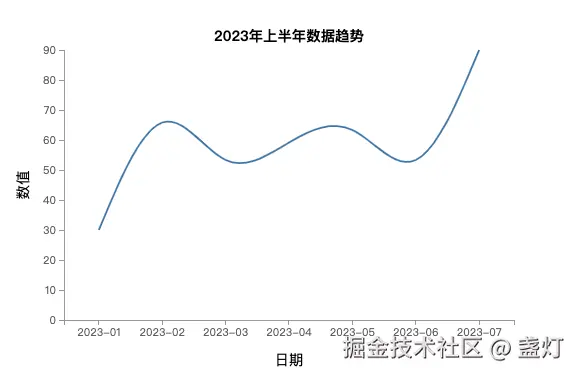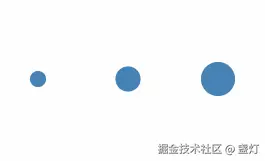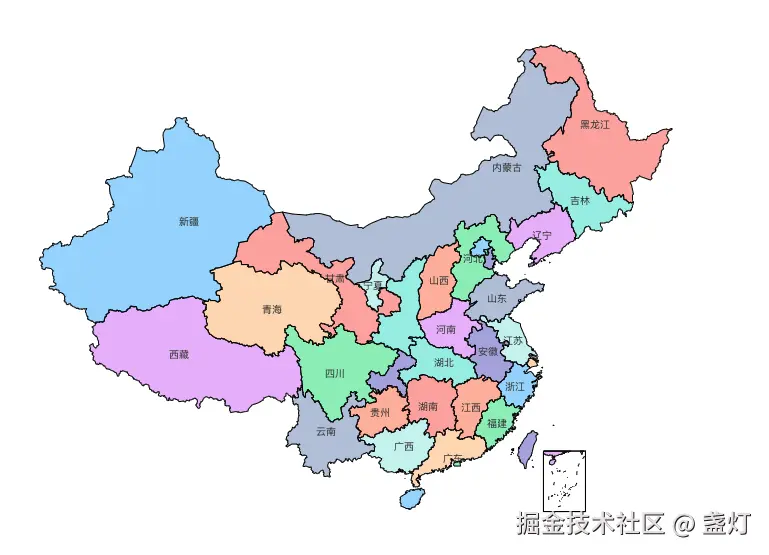正文
D3.js (Data-Driven Documents) 是一个强大被数据驱动的js库,用于基于数据创建动态、交互式的可视化。
D3 可以接受几乎任何数字数组,字符串,或对象(本身包含其他数组或键 / 值对),可以处理 JSON 和 GeoJSON。比如说:
js
[
{ source: 'Microsoft', target: 'Amazon', type: 'licensing' },
{ source: 'Microsoft', target: 'HTC', type: 'licensing' },
{ source: 'Samsung', target: 'Apple', type: 'suit' },
{ source: 'Motorola', target: 'Apple', type: 'suit' },
{ source: 'Nokia', target: 'Apple', type: 'resolved' },
{ source: 'HTC', target: 'Apple', type: 'suit' },
{ source: 'Kodak', target: 'Apple', type: 'suit' },
{ source: 'Microsoft', target: 'Barnes & Noble', type: 'suit' },
{ source: 'Microsoft', target: 'Foxconn', type: 'suit' },
...
]一、D3.js基础入门
1. D3.js概述与安装
D3.j通过绑定数据到DOM元素,然后根据这些数据驱动文档的变换,实现数据可视化。它结合了强大的可视化组件和数据驱动的DOM操作方法。
安装方法:
html
<!-- 直接引入CDN -->
<script src="https://d3js.org/d3.v7.min.js"></script>
<!-- 或者使用npm安装 -->
npm install d32. 元素操作基础
D3使用类似jQuery的选择器语法来操作DOM元素:
javascript
// 选择所有p元素并设置样式
d3.selectAll("p")
.style("color", "blue")
.attr("class", "highlight")
.text("Hello D3!");
// 添加新元素
d3.select("body")
.append("div")
.attr("id", "new-div")
.html("<p>This is a new div</p>");二、数据绑定与更新
1. 数据绑定基础
D3的核心是数据绑定机制,它通过.data()方法将数据数组与DOM元素绑定:
javascript
const dataset = [10, 20, 30, 40, 50];
// 绑定数据并创建新元素
d3.select("body").selectAll("div")
.data(dataset)
.enter()
.append("div")
.text(d => d)
.style("height", d => d + "px");2. 数据更新模式
D3提供了enter、update和exit三种状态处理数据变化:
javascript
// 更新数据
const newData = [15, 25, 35];
// 选择现有元素
const bars = d3.select("body").selectAll("div").data(newData);
// 处理新增元素
bars.enter()
.append("div")
.text(d => d);
// 处理更新元素
bars.text(d => d);
// 处理删除元素
bars.exit().remove();三、比例尺与坐标轴
1. 线性比例尺应用
比例尺将数据值映射到可视化空间:
javascript
const dataset = [10, 25, 50, 100, 150, 200, 250];
// 创建线性比例尺
const xScale = d3.scaleLinear()
.domain([0, d3.max(dataset)]) // 数据范围
.range([0, 500]); // 输出范围
// 使用比例尺
d3.selectAll("div")
.style("width", d => xScale(d) + "px");
2. 坐标轴绘制
D3提供了方便的坐标轴生成器:
javascript
// 创建坐标轴
const xAxis = d3.axisBottom(xScale)
.ticks(5)
.tickFormat(d => "¥" + d);
// 添加坐标轴到SVG
d3.select("svg")
.append("g")
.attr("transform", "translate(0, 300)")
.call(xAxis);
四、图形生成器
1. 饼图实现
javascript
const pie = d3.pie()
.value(d => d.value);
const arc = d3.arc()
.innerRadius(0)
.outerRadius(100);
const arcs = pie([
{value: 35, name: "A"},
{value: 25, name: "B"},
{value: 40, name: "C"}
]);
d3.select("svg").selectAll("path")
.data(arcs)
.enter()
.append("path")
.attr("d", arc)
.attr("fill", (d, i) => d3.schemeCategory10[i]);
2. 折线图实现
html
<div class="chart-container">
<svg width="100%" height="100%"></svg>
</div>
javascript
const line = d3.line()
.x(d => xScale(d.date))
.y(d => yScale(d.value))
.curve(d3.curveBasis);
d3.select("svg")
.append("path")
.datum(data)
.attr("d", line)
.attr("fill", "none")
.attr("stroke", "steelblue")
.attr("stroke-width", 2);
五、交互与动画
1. 过渡动画
javascript
d3.selectAll("circle")
.transition()
.duration(1000)
.attr("r", d => d * 2)
.attr("fill", "red")
.transition()
.duration(500)
.attr("fill", "blue");
2. 拖拽交互
javascript
const drag = d3.drag()
.on("drag", function(event) {
d3.select(this)
.attr("cx", event.x)
.attr("cy", event.y);
});
d3.select("circle").call(drag);
中国地图实现

javascript
// 创建投影
const projection = d3.geoMercator()
.center([105, 38])
.scale(800)
.translate([width/2, height/2]);
// 创建路径生成器
const path = d3.geoPath()
.projection(projection);
// 加载GeoJSON数据并绘制
d3.json("https://geojson.cn/api/china/1.6.2/china.topo.json").then(function(data) {
svg.selectAll("path")
.data(data.features)
.enter()
.append("path")
.attr("d", path)
.attr("fill", "#69b3a2")
.attr("stroke", "#fff");
});总结
借助SVG, Canvas 以及 HTML一些dom去把json一些数据根据一些图形展示出来。
官网有现成的例子,可以直接拿来用。借助SVG, Canvas 以及 HTML一些dom去把json一些数据根据一些图形展示出来。
一开始有时候有人看到这种很多很奇特的图形效果,很容易被吓住,觉得自己一定搞不赢。其实很多时候是数据的变动和不同,再结合人家已经写好的封装好的东西,再具体情况具体分析去一步步做出来的。